Doorhandle
Well-Known Member
- Joined
- Aug 21, 2013
- Messages
- 52
Hey all, Ive been checking out a variety of spots and I wanted some clarification on something. Can someone define a "pool" for me? How often do they occur in rivers? My friend and I were just at the credit and we walk a good ways without finding any still water or anything that might resemble a pool. Was this maybe because of all the rain we had, which made the river too fast for them?
Thanks, just trying to find the fishies.
Thanks, just trying to find the fishies.

